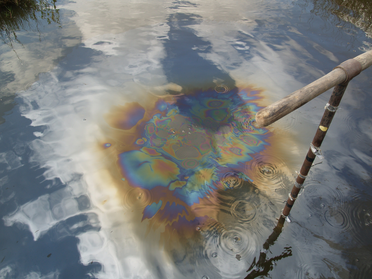|
The root zone – that interface between root and soil – shows me one of the most primary connections between molecular processes and human social purpose. As a student, gardener, educator, and community scientist, I’ve spent almost 20 years investigating sustainable agriculture, soil geochemistry, and toxicity. These areas of fascination remained separate for me until one afternoon in August 2005 on a visit to New Orleans. Hurricane Katrina struck and, in her wake, I found myself wading through toxic floodwaters unleashed by broken levees. I saw iridescent rainbows floating on top of water dark with sediment, smelled the volatile organics. I imagined the heavy metals and persistent hydrocarbons sinking into the soil as the waters receded. I realized that as a species, our relationship to the ground has never been more precarious.
Escaping Katrina, I evacuated back to my sustainable agriculture apprenticeship in Tennessee. Compared to many people who experienced the hurricane, I was privileged – instead of losing my home, I had a cozy room on a community farm where I could welcome the people I evacuated with. As the shock wore off, I thought about the flood's apparent toxicity, trying to connect those polluted waters with long-term contaminant levels in the city. I found that the poison was nothing new; New Orleans' historically high lead concentrations have been studied extensively. For the next two years I traveled between New Orleans, my home in Tennessee, and post-industrial Milwaukee, conducting site visits with urban gardeners who worked in contaminated soil like that of New Orleans. I wanted to understand grassroots approaches to soil remediation, their relationship to the underlying soil chemistry. Some of what I found shocked me. One gardener picked up a sunflower, explained to me that it had “cleaned up” the lead, and casually tossed it into the compost pile! Any lead in that sunflower would now be re-entering the soil cycle – but the plant may well have contained minimal lead. Lead is a tenacious element that bonds strongly to soil particles, with only limited bioavailability. I reviewed the literature and found that lead phytoremediation is controversial, possibly ineffective (Chaney et al., 2007). Why was that gardener so excited about removing lead with sunflowers, and why didn’t that person know that it wouldn’t work? Plant-based soil clean-up methods are compelling to urban gardeners, community activists, and researchers alike. Known broadly as phytoremediation, these techniques have the appeal of being almost undeniably green, and seemly affordable to anyone with a green thumb. Harnessing the unique capabilities of hyperaccumulators – relatively rare plants that can sequester high concentrations of toxic elements in their aboveground tissue (leaves, fronds, etc) – is particularly attractive. But the ability of a plant to remove metals from soil is governed as much by the behavior of the metal in the soil, as it is by the plant. For example, I study a hyperaccumulator of arsenic, the brake fern, Pteris vittata L. This fern is able to tolerate extremely high concentrations (several thousand parts per million) of arsenic in its fronds, but soil remediation with P. vittata is still relatively slow. This opens the door to my research, looking at arsenic and nutrient biogeochemical cycling in the root zone, to understand how we can speed up arsenic uptake in the fern. Let’s go back to the sunflower in the compost pile. I know the person who tossed it there had the best intentions, but was simply uninformed. This knowledge gap is what motivates me to pursue a PhD in plant-based soil remediation methods: so I can help translate and spread this knowledge to interested people. I’m inspired by the training-the-trainer model practiced in agroecology, with hopes of using horizontal knowledge transfer to facilitate a growing team of urban agriculturalists well educated about their soil and the plants that thrive in it. Sources: Chaney, R.L., Angle, J.S., Broadhurst, C.L., Peters, C.A., Tappero, R. V, and Sparks, D.L. (2007). Improved understanding of hyperaccumulation yields commercial phytoextraction and phytomining technologies. J. Environ. Qual. 36, 1429–1443.
2 Comments
4/25/2024 03:39:53 am
Gartenzaun: Ein Gartenzaun dient nicht nur der Abgrenzung Ihres Grundstücks, sondern kann auch als gestalterisches Element dienen, das Ihrem Garten Charakter verleiht. Von klassischen Holzzäunen bis hin zu modernen Metallkonstruktionen gibt es zahlreiche Optionen, die zu Ihrem individuellen Stil passen.
Reply
Leave a Reply. |
AuthorSarick Matzen completed his PhD in Environmental Science, Policy, and Management department at University of California, Berkeley in 2020. He is now a postdoc in the Soil, Water, and Climate Department at the University of Minnesota working on iron cycling in marine systems. Archives
July 2019
Categories |

 RSS Feed
RSS Feed
